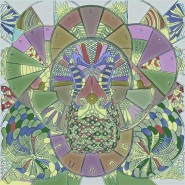 Tunng
Tunng...And Then We Saw Land
Score: 93
Folk and electronic aren’t exactly the most obvious musical companions. But for UK “folktronica” group Tunng, who released their newest album, …And Then We Saw Land, on the 6th, it simply works. …And Then We Saw Land combines a well-orchestrated folk base with electronic flourishes that, along with a good bit of creativity, create a genuinely interesting album.
Folktronica seems to be working extremely well for Tunng. Folk is naturally beautiful, but it can often lack instrumental variation. With its electronic/experimental approach to the genre Tunng has created a very diverse album, still rich, intricate, and delicate or powerful as necessary. The cycling use of keyboard, acoustic and electric guitar, and percussion creates an extremely full experience, even as tracks remain to some degree linked. Equally impressively, experimental albums will by their nature often contain some failures, yet …And Then We Saw Land has no obviously weak tracks, even if there are some identifiably weak elements.
Lead vocal duties on …And Then We Saw Land are shared by Mike Lindsay and Becky Jacobs (the latter of whom steps up to replace founder Sam Genders, who left after the band’s 2007 album Good Arrows). The richness lent to Tunng’s music by its instrumentals is absolutely supported by its vocalists, both of whom do an admirable job drawing the images of Tunng’s various stories. Lindsay’s deeper baseline meshes with Jacobs’ clear tones, creating a conversation of sorts that continues through the album.
At the beginning of the album, …And Then We Saw Land’s lyrics are somewhat worrying - the beginning of opening track “Hustle” isn’t all that interesting, but by the time Tunng reaches the end of the track, they’ve shifted into the much deeper gear in which the album as a whole runs, never looking back. Tunng tells stories very well with simple lyrics - one of the album’s best tracks, “With Whisky,” creates a beautifully elegant image with descriptive remembrances, which “Sashimi” uses short phrases and bits of cut-in recordings to create a more energetic environment.
…And Then We Saw Land gets richness from its folk basis, creativity from its experimental side, and on top of it all, manages to stay very catchy and forceful through even the strangest sections. While tracks are often just a bit too long for their own good, they vary enough that they remain engaging all the way through. And …And Then We Saw Land certainly doesn’t stop at minimally necessary levels of variance; Tunng excels in its transitions, the best of which include the choral crescendo first appearing after the first third of “Don’t Look Down or Back” and the sudden, near-magical a capella insert towards the end of “October.”
Simply put, …And Then We Saw Land is a rare album. There aren’t many opportunities to hear strong rock solos that somehow fit well in the middle of folk tunes, and “By Dusk They Were in the City” isn’t even one the strongest tracks on the album. …And Then We Saw Land has so much to offer, from it’s rather unique percussion (especially on “Weekend Away”) and curious electronics, to the amazing vocals and deeply rich guitar. …And Then We Saw Land has its faults, but sounds, overall, incredibly good.